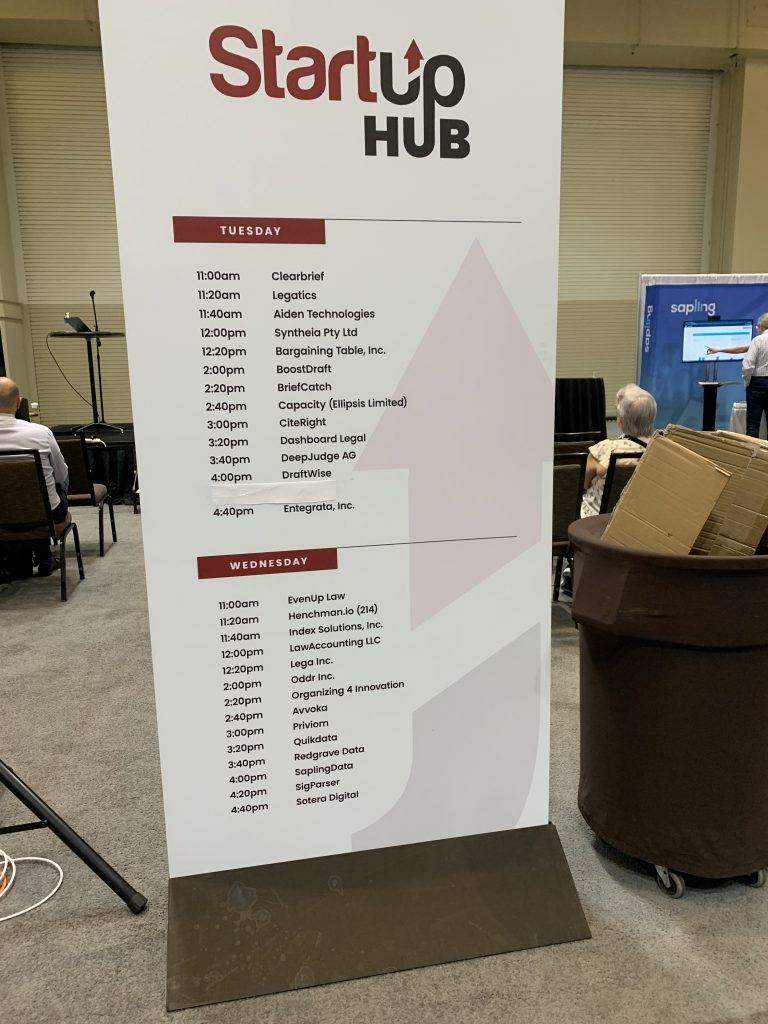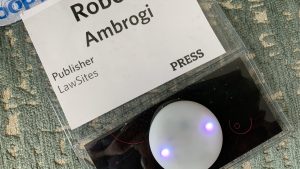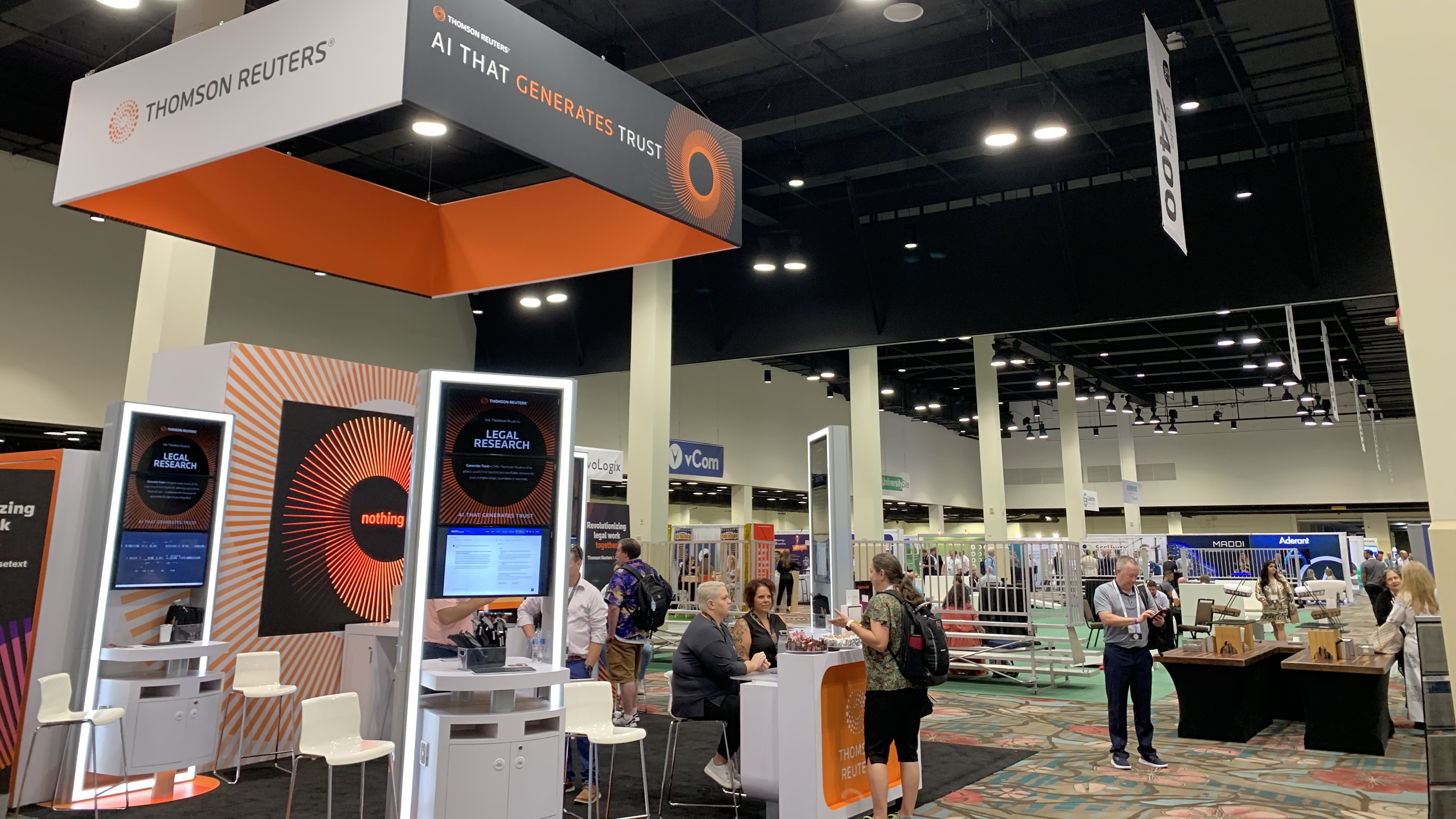Spread across five days and with some 350 distinct educational opportunities, ILTACON 2023, the annual conference of the International Legal Technology Association, is a marathon, not a sprint. But it was a marathon well worth the effort, and almost all of the attendees I spoke to considered themselves winners for having participated.
When I say it was more a marathon than a sprint, there was some literal as well as figurative truth to that this year. Conference events spanned some 431,000 square feet of activity space, and while the conference was centered in the side-by-side Disney Dolphin and Swan hotels, it spilled over into farther-afield buildings on the Disney campus, sometimes requiring walks of three-quarters of a mile just to get from one meeting to another – walks, mind you, outdoors in the swampy heat of Orlando in August. Even on one of my most stationary days of the conference, I clocked over 10,000 steps.
But, walking aside, in almost every other way, this year’s ILTACON was a success. With over 3,400 registrants, attendance was up from the last two years (although still lower than 2019’s 3,800). The exhibit hall was robust, with 158 exhibitors and a steady flow of interested prospects. The educational opportunities were, as I said, ample, as well as diverse and substantive in their content. Opportunities for socializing and eating and drinking and partying were abundant.
Programs and Exhibitors
 For most attendees, the main reason they were there was for the opportunities to learn from experts and colleagues in their fields. Because so much of my schedule was filled with briefings from legal tech companies, I attended very few educational programs. But the feedback I received from others who did attend programs was consistently positive, with praise for both the range of topics and the quality of the speakers.
For most attendees, the main reason they were there was for the opportunities to learn from experts and colleagues in their fields. Because so much of my schedule was filled with briefings from legal tech companies, I attended very few educational programs. But the feedback I received from others who did attend programs was consistently positive, with praise for both the range of topics and the quality of the speakers.
For the exhibitors who attended, their goal, of course, was not to learn, but to sell. Here again, the exhibitors I spoke to were quite pleased with the flow of traffic to their booths and the quality of the interactions they had with the attendees who came to their booths.
This was true even though the large exhibit hall was poorly laid out – divided into front and rear sections in a way that favored exhibitors lucky enough to be in the front section and disfavored those in the rear. But even in that rear section, exhibitors told me that they were pleased with the overall traffic to their booths.
For those attendees who ventured all the way back to the furthest most reaches of the exhibit hall, they would have been rewarded with discovering the ILTACON Startup Hub, featuring 27 legal tech startups. In addition to each startup having a booth in that section, each got the chance to take to a small stage in the Startup Hub and give a short presentation about their product, with those presentations running all day over the course of two days.
Sprawling Venue
As for the conference venue, I would rate it a “meh.” Not sure why I have become so cranky in recent years about conference venues. Last year, I made no secret of my dislike of the Gaylord Nashville, where ClioCon was held, calling it sprawling and byzantine, and just last month, I wrote about how the venue of the American Association of Law Libraries annual conference seemed so disjointed that it left the conference with no center of gravity.
This year, ILTACON suffered somewhat – or, I should say, its attendees suffered greatly – from its spread across multiple venues, the good news is that it managed not to feel disjointed despite its sprawl. This was thanks to the Dolphin serving as its anchor. With the registration area in the Dolphin, the exhibit hall in the Dolphin, the opening and closing receptions in the Dolphin, and breakfasts and lunches in the Dolphin, it very much provided a center of gravity to anchor the conference. In addition, the Dolphin’s always-bustling lobby bar served as a social hub for the conference.
Parties Galore
Of course, no conference is complete without parties and receptions to fuel networking and entertain attendees after hours. When it comes to parties, ILTACON never disappoints. The hardest decisions attendees had to make each day were which events to attend each evening.
ILTA itself always throws good parties, including the opening night reception, the exhibit hall opening, and the closing night party. But the vendor-sponsored parties are often the ones not to be missed. This year’s hot party ticket was for the iManage after party, with attendees lining up at its booth early on the day of the party for a coveted admission wristband. Held in the cavernous World ShowPlace Pavilion directly within Epcot, with a 90s-themed band and a liberal flow of liquor, it was by far the loudest and most packed party of the week.
Klik Rapt?
 If the most talked about technology at ILTACON was generative AI, then the second most talked about was Klik, the so-called smart badges given to attendees. These name badges bore a while button you could hold next to another attendee’s badge and click to exchange contact information, with each person’s button lighting up green to confirm that the exchange was made. The buttons would also inexplicably light up and flash at other random moments, leading some attendees to wonder whether the devices were somehow tracking their activity.
If the most talked about technology at ILTACON was generative AI, then the second most talked about was Klik, the so-called smart badges given to attendees. These name badges bore a while button you could hold next to another attendee’s badge and click to exchange contact information, with each person’s button lighting up green to confirm that the exchange was made. The buttons would also inexplicably light up and flash at other random moments, leading some attendees to wonder whether the devices were somehow tracking their activity.
As I wrote earlier this week, the initial drama over these badges was the news that attendees who failed to return them would be fined $50. The problem with this was that this was not made clear to attendees when they registered. Apparently, some were told this when they picked up their badges, but clearly not everyone. After I wrote about it on Monday, I had dozens of people thank me for saving them the $50 fine.
But that was not the only problem with the Klik badges. The whole idea of them was to quickly share and save contacts. But for some people, I was told, it saved only some of the contacts they thought they had made.
I first heard of this Wednesday night, when someone told me that she had been told by someone else that they had tracked the Klik contacts and found that not all were getting saved. She tracked it for herself, she said, and had the same outcome.
I cannot say for sure that the app failed to collect all contacts. It is quite possible people did not click it correctly or simply misremembered which contacts they’d collected. If you had this problem at all, please let me know.
Vibrancy and Energy
Whenever I write a post-mortem on a conference, I base my evaluation in part on my own gut impressions, but I also put a lot of stock in the conversations I have with others during the conference. They provide a gut check, if you will, confirming or countering my own takeaways.
My gut this year tells me that this was one of the best ILTACONs I’ve attended, and my conversational gut checks consistently confirmed that. Yeah, people complained a bit about the spread across multiple buildings and all the walking in the 90 degree heat. Yeah, some vendors complained about the poor layout of the exhibit hall, mostly those in the back half. But virtually everyone I spoke to – whether attendee or vendor or whatever other role brought them there – told me that they had a good conference and got out of it something close to what they’d hoped to get out of it.
There was an undeniable vibrancy and energy to this year’s ILTACON. That could be attributable to several factors, not least of which is our continuing joy at simply being able to once again congregate after the lock down of the pandemic.
But I also think the vibrancy of the conference reflected the vibrancy of the legal tech industry more broadly at this moment in time – a vibrancy fueled by the excitement around generative AI and the new spirit of innovation it has engendered throughout the industry.
Regular readers may think it hypocritical of me to say that, given that when I wrote just last month about the sense of malaise at the AALL conference, I blamed it on the air of uncertainty there brought on by the broader uncertainly around generative AI and its potential impact on legal professionals.
But there are two sides to that coin. If there is uncertainty about generative AI, there is also excitement. And ILTACON’s attendees are a very different group than AALL’s. Many work in innovation and IT within their firms and organizations, and are directly involved in managing, deploying and using technology. Of the attendees I spoke to this week, many seem to be cautiously hopeful about the possibilities of generative AI.
There is a buzz across the legal industry that we are on the cusp of major change, and ILTACON seemed to encapsulate some of that buzz – a conference excited about where we are today and curious about what the future holds.
 Robert Ambrogi Blog
Robert Ambrogi Blog